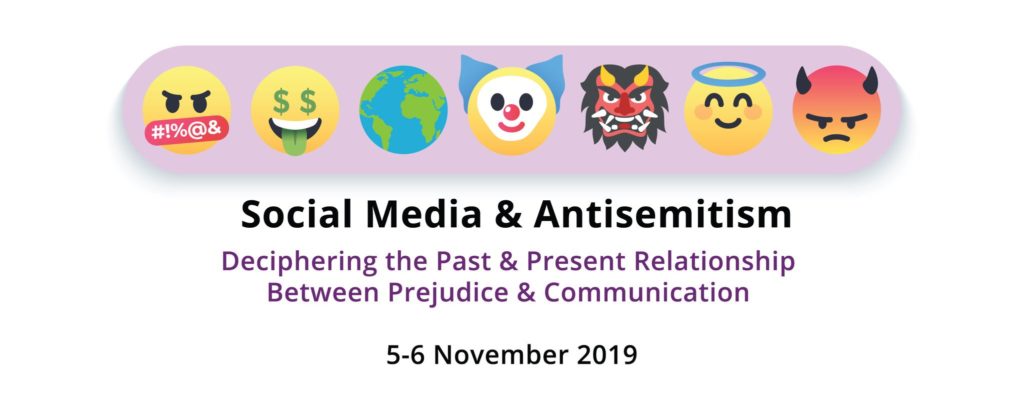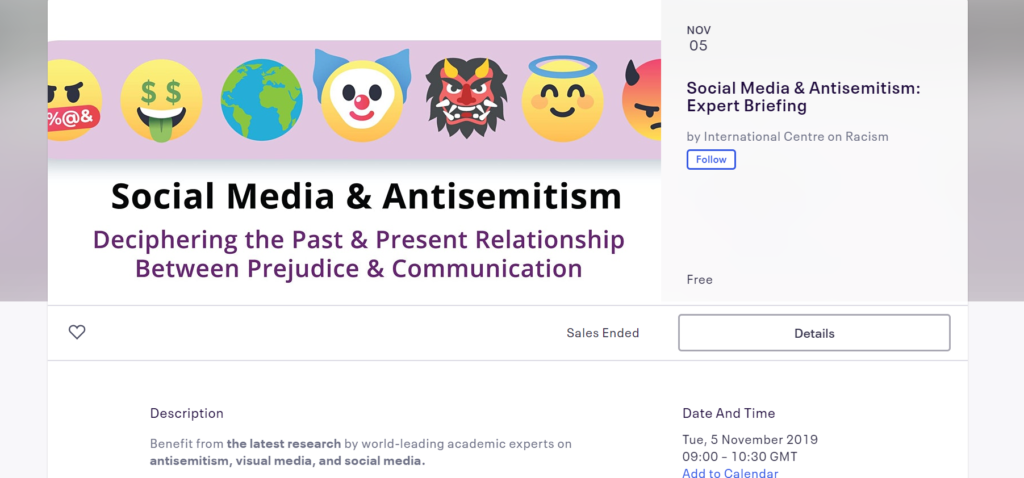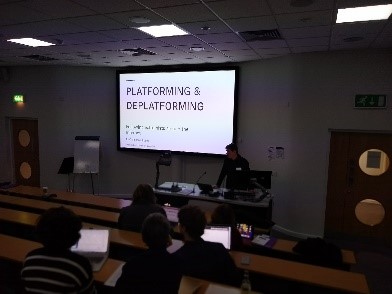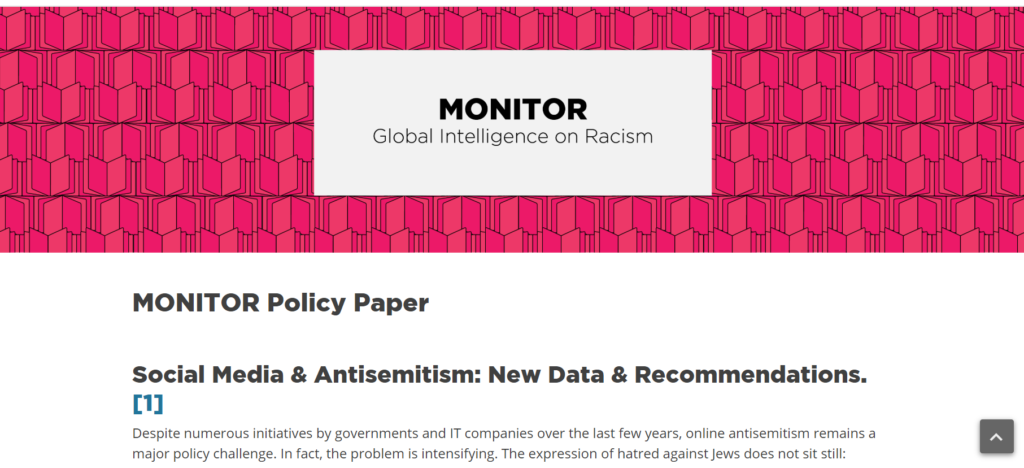
Organisers
MONITOR Global Intelligence on Racism, RSCAS, European University Institute, Italy.
International Centre on Racism (ICR), Edge Hill University, UK (CONFERENCE HOST).
Zentrum für Antisemitismusforschung (ZfA), Technische Universität Berlin, Germany.
Funded by

Aims
Social media is impacting in significant ways on anti-Jewish racism- but what is novel about this relationship? Focused on this question, Edge Hill University, UK, hosted the first conference to analyse the connection between innovations in media and changes in antisemitism over the longue durée. Funded by the European Association for Jewish Studies, the event was a collaboration between the magazine MONITOR Global Intelligence on Racism (Monica Gonzalez-Correa) at the Robert Schuman Centre for Advanced Studies, European University Institute, Florence, Edge Hill’s new International Centre on Racism (ICR) (James Renton and Jenny Barrett), and the Zentrum für Antisemitismusforschung (ZfA) (Stefanie Schüler-Springorum, Uffa Jensen, and Marcus Funck) at the Technische Universität Berlin.
A principal aim of the conference was to bring experts in the digital humanities, literature, law, social sciences, and history into dialogue. With historian Professor Stefanie Schüler-Springorum (ZfA) and web epistemologist Professor Richard Rogers (Amsterdam) as keynotes, the organisers attracted participants in these fields from Germany, Israel, Norway, the UK, and the United States.
Scholars, analysts and policymakers have pointed to social media for some time as a driving force behind the increasing virulence of antisemitism. This new form of communication has evidently played an important role in the recent spike in violent attacks and murder of Jews by lone-wolf killers in the United States and Europe. The killers have interacted with like-minded people online, used the web as a means of articulating their ideology, and a platform for broadcasting their acts of violence. Beyond the realm of physical violence, antisemites are engaging with each other globally in new ways, are developing new forms of expression, and antisemitic notions and languages have moved into mainstream online debate and politics.
In order to combat this online racism effectively, we must decipher what, if anything, is really new – in form as well as content. Yet, the fundamental question remains: how can the novelty of contemporary antisemitic ideas, practices, and networks be assessed? The answer must begin, the conference organisers argue, by analysing new developments within a bigger historical framework: the relationship between media and antisemitism over the centuries. In collaboration, the meeting of academic disciplines can, we contend, sketch out new paradigms of analysis. In turn, this larger canvas provides new possibilities for thinking about effective anti-antisemitism.
Outcomes
The conference achieved our goal of providing a new temporal and multi-disciplinary framework for thinking about our subject; we began our analyses in medieval history, extended our discussions into modernity, and then delved into the recent past and the present. The speaker panel included scholars of literature, law, history, the social sciences, and digital humanities. Following recent scholarship on antisemitism, much of our discussions were embedded in the bigger subjects of the far-right, digital culture, and the relational dynamics between racisms.
Taken together, the conference established clear connecting elements that are pronounced in particular moments (for example between early modern Spain and contemporary global digital culture). This is not to say that we found unchanging features of antisemitism- to the contrary. Instead, the research unearthed points of similarity between points in time, including characteristics, defining emotions, and practices, that are brought into sharp relief by our deep historical approach. At the same time, the conference findings also underscore distinctive features of seminal junctures that are tied to innovations in media, and accompanying changes in political, economic, and social cultures.
Significantly for those combating antisemitism today, these findings include the unveiling of new evidence of effective contemporary antiracism strategies, along with suggestive parallels from the past.
These findings are to be communicated via an open access peer-reviewed publication edited by Monica Gonzalez-Correa, MONITOR, EUI, Michael Berkowitz, University College London, and James Renton, Edge Hill University.
The partnership between MONITOR and the ICR has been formalised, and their ongoing events and publications continue to examine antisemitism in the context of other racisms over the longue durée. Their next conference will be on ‘Centring Race in History’, and a webinar series on antiracism in the 2020’s after George Floyd. MONITOR and the ICR will also discuss future collaborations with the ZfA.
Papers and Discussion
The conference was opened by Professor George Talbot, Pro-Vice Chancellor for Research and Dean of the Faculty of Arts and Sciences, Edge Hill University.
Medieval Hate
The first panel began with media innovation and antisemitism in medieval Europe. It was chaired by Professor Uffa Jensen, an historian from one of the organising institutions, Technische Universität Berlin, and expert on visual antisemitism. Dr Marcia Kupfer, an art historian based in Washington DC and author of a Yale University Press monograph on the Hereford map, opened proceedings.
Kupfer argued that medieval Christianity’s adoption of the medium of the parchment codex led to it becoming a significant element in the projection of supersessionist theology—of Christianity as Judaism’s replacement. In medieval art, the object of the codex was presented as the glorious encasement of Christ’s teaching, in opposition to the scroll, the embodiment of Judaism as a backward religion. Kupfer went on to discuss the depiction of the Jew in carnival culture, of antisemitism as popular entertainment, rather than theological argument, focused on the controversy over the Aalst carnival.
Medievalist, Dr Lindsay Kaplan, from Georgetown University followed. Kaplan’s paper drew on her new monograph on racism in medieval Europe, and focused specifically on the medium of illuminations in psalters, manuscripts of psalms, which were the most widely read and circulated books of the Bible in the Middle Ages. Kaplan argued that there were marked shifts in these psalters from the 11th century, through to the 13th century, in which Jews became the central protagonists in the killing of Christ. In addition, dark Muslims emerge as the partners of the Jews, as anti-Islam and anti-Judaism become racialised in this imagery.
In the discussion that followed the panel, Professor Kitty Millet, San Francisco State University, noted the evolution of the Aalst carnival, and even more extreme antisemitism in the past with the depiction of gestapo guards and Zyklon B. A particular focus of the discussion then centred on racialisation in medieval Europe, and the relationship between figures of the Muslim and the Jew.
Keynote: “Eyes and Ears, Heart and Soul: Anti-Jewish Resentment and the Media: A historical perspective.”
Professor Stefanie Schüler-Springorum, Director of the ZfA, delivered the first keynote of the conference. The Director of the Pears Institute for the Study of Antisemitism, Professor David Feldman, presided over the session.
Schüler-Springorum gave a sweeping lecture that provided an essential link between the medieval session, and the modern/postmodern papers that followed. A highly original contribution, the lecture explored the different senses (seeing, hearing, tasting, and smelling) through which anti-Judaism was conveyed via the media revolutions of modernity (the printing press, sermons, radio, the poster and the postcard, mass theatrical events). Schüler-Springorum argued that joy and amusement were critical emotional features of modern antisemitism.
With regard to the change inaugurated by the printing press and the circulation of books, Schüler-Springorum presented the case that early modern Spain was the originator of defining concepts in the history of antisemitism: Jewish and Muslim racial difference, and the Jewish conspiracy. Whereas most scholarship has pointed to Iberia as a case apart, the presentation contended that books from this part of Europe travelled into central Europe and the new world, and had a profound impact on humanism, the reformation and counter-reformation.
Another critical element of the lecture was the emphasis on participation in mass theatrical events. These range from the auto da fe in Iberia to carnival, football matches, and the web. Schüler-Springorum showed how spectacles themselves pass into different media in history: Francesco Rizzi paintings, Lopez de V songs, Shakespeare plays, to name but a few examples.
As one would expect, lively discussion followed, raising points including early modern “racism” (Kaplan); philology versus biology as the root of race, and the Iberia moment as a strong but not initiating point in antisemitism history (Feldman).
Modern/Postmodern Transitions and Continuities
The next panel shifted our attention to ‘Modern/Postmodern Transitions and Continuities’. It began with Dr James Smith (Royal Holloway, University of London), whose paper, ‘From Trope to Meme’, addressed the UK debate over Jeremy Corbyn and the Labour Party. He argued that we need to consider the nature of digital media and changes in knowledge, and how they interact with the very quick growth of an explicitly democratic mass political movement (over half a million members). Smith pointed to the theoretical importance of conceptualising digital media as a technology of desire, and a post-modern technology, as well as how old debates among the liberal left around antisemitism are projected onto faceless masses.
Expanding on a key theme in this conversation—the conspiracy theory— Dr Martina L. Weisz (Hebrew University) discussed its contemporary history in the Spanish daily press, especially El País, El Mundo and ABC. Weisz argued that the Jewish conspiracy theory has remained prevalent in print and online in this media from the 1990s to the present. Her starting point was the controversy over the publication by Penguin in English of the book, How They Rule the World, by Pedro Baños, a text that, significantly, was not deemed to be problematic in Spain.
Keeping with the same theme of conspiracy, but shifting to the context of the United States, Dr Victoria Woeste analysed the history of the Protocols of the Elders of Zion. Her presentation traced the unfolding impact of conspiratorial antisemitism from the early twentieth century in print media, and its legacies in the question of news in the era of Donald Trump. Her presentation compared Henry Ford, who was pivotal in the dissemination of the Protocols in the US, with Trump.
Keynote: “Deplatforming: Following Extremists to Telegram and Alternative Social Media.”
The second day of the conference started with a keynote by the world-leading digital media specialist, Professor Richard Rogers, from the University of Amsterdam. This talk took the conference into the question of how we can respond effectively to online antisemitism. Rogers explored the broad question of whether deplatforming—removing individuals from platforms including Twitter, YouTube, and Facebook—is a successful strategy. His analysis drew upon intensive digital research that he undertook with a group at the University of Bologna. They found that deplatforming did indeed reduce the reach of formerly high-profile extremists, that it reduced their income streams, and had a positive effect on the mainstream platforms that excluded them. Even though they can migrate to other platforms such as Telegram, far-right/alt-right new media celebrities end up with much smaller audiences and exposure.
In the discussion that followed, Dr Aaron Winter (University of East London), pointed out that we must look at the complex political context of prominent individuals, and not just the technical digital side, as they can stride across a ‘liberal Islamophobia’ as well as fringe alt-right fascism. Dr Ben Gidley (Birkbeck) followed with a discussion about deplatforming, the role of software as an intermediary, and the older political strategy of ‘No Platforming’. Rogers concluded by pointing to the contemporary challenges of effective digital research due to restrictions placed on accessing data by platforms such as Facebook.
Far right/alt right
Dr Ariel Koch (Tel Aviv University) kicked off the panel with an examination of the global activism undertaken by the extremist online group, the ‘Atomwaffen Division’. Koch outlined the eclectic ideological influences evinced by the group, from Hindu eschatology to jihadism. The official website is only found on the dark web, and Koch discussed its ideological make-up, with its aim of ‘white jihad’. Whereas those involved would have inhabited a markedly fringe political space years ago, they now have a transnational reach across the darker side of the web.
The theme of mainstreaming was then taken up further by Dr Aaron Winter (UEL) in his presentation concerning the alt-right. Winter discussed older attempts by, for example, the KKK to enter the mainstream, and early use of the internet. But he pointed to two fundamental shifts that have enabled the far-right to become normalised: 9/11, and the Presidency of Barack Obama. The result is ‘Trumpism’, which binds a diverse movement that incorporates liberal Islamophobia and anti-Black racism.
In the panel discussion, Weisz pointed to the resonance between the ideology of the online right and the eschatology of settler Zionism.
Identities
The next panel dealt with identities. It delved further into the transnational development of online far-right hate, and the relationship between the online and off-line political worlds that this politics inhabits. Professor Kitty Millet (San Francisco State) focused on Polish nationalism, with the relationship between the political crowd of street protest, the football stadium and football culture, and the recruitment/growth of far-right groups. Millet showed how the ideas and political languages being developed and enunciated in this political space are having transnational impacts around the globe, including the United States, with antisemitism and the figure of the Jewish enemy as a binding force. Critically, the digital space functions as the infrastructure for this transnational political activism.
Birgitte P. Haanshuus (Oslo) followed, and spoke about her research on the political left and online antisemitic hate speech in Norway. Her research focuses on the official Facebook pages of organisations that include the Red Party (Rødt), Palestine Committee, BDS Norway, Radikal Portal. Each of these left-wing groups hold either a pro-Palestinian and/or anti-Israel perspective. Using content analysis and interviews, Haanshuus has found that antisemitism is rarely an issue on these pages. Her interest, however, lies in how potential antisemitic content is moderated, given that those running the organisations are aware of its potential— in other words, how is online hate policed in the virtual space, depending on the conceptions of those in a position of authority.
Dr Matthias Becker (Haifa University) also explored the virtual space of hate speech, focused on the UK in relation to Brexit. His talk discussed British news websites and Facebook, and considered whether exclusionary speech has become mainstream concerning Jews, along with Muslims and European immigrants. The focus on the seeping of hate into mainstream discourse dovetailed with several other contributions to the conference, as did the relational approach of exploring antisemitism with other racisms. In addition, Becker made a significant argument in regard to methodology: the importance of combining quantitative digital analysis with qualitative analysis. This point echoed Winter’s argument about the significance of attending to the political context of any digital change.
Antiracism
The penultimate panel addressed how we can respond effectively against antisemitism. Following the keynote by Richard Rogers, this session brought historical insights from print-media antiracism into dialogue with the latest digital research on what works in social media. Dr Patrick Soulsby (Edge Hill, ICR) analysed comparatively two prominent publications in France and the UK in the 1980’s and 1990’s: Le Droit de Vivre, published by the Ligue internationale contre le racisme et l’antisémitisme (LICRA), founded in 1927, and Searchlight magazine, founded in 1975. Even though these publications did not collaborate, their approaches had significant similarities. Both adapted over time in dynamic response to changes in antisemitism and the far-right, and represented an engagement between antiracism and anti-antisemitism. Perhaps most importantly they provided a successful model of intelligence gathering on far-right political activity, which was absolutely crucial for informing antiracists. Searchlight, in particular, possessed a national network that was able to gather real-time information on developments as they happened, enabling effective activism across the country.
From these models of a print-media response to antisemitism, the panel moved into the digital realm with the research of Dr Sefa Ozalp and his colleagues at the HateLab at Cardiff University. Ozalp presented new work that analysed Twitter in the UK for one year from October 2015. Using computational criminology methodology, the team used a machine learning classifier, identifying almost 3 million tweets. The project measured the impact, the digital lifecycle, of antisemitic tweets, as well as countervailing material from those against anti-Jewish online social media. A very important finding was that antisemitic tweets had a smaller and more short-lived influence than those producing anti-racist messages. In short, the recommendation is that widespread organic responses that challenge antisemitism work.
Reflections on Media History and Antisemitism
The final panel gathered several scholars from the conference to reflect on the key themes discussed. The panel began with the Deputy-Director of the ZfA, Professor Uffa Jensen. Jensen praised the multi-disciplinary discussions of the conference, and was particularly struck by the ways in which contributors contextualised antisemitism (and anti-antisemitism) in relation to other racisms. He also pointed to the significance of gender as a field for further investigation, specifically questions around masculinity, and deplatforming as a potential antisemitic trope. Professor David Feldman, Director of the Pears Institute for the Study of Antisemitism (Birkbeck, University of London) followed by arguing that we need to consider the history of print news (including fake news), and printed books for us to get to grips with contemporary social media. Feldman stated that Benedict Anderson’s notion of ‘imagined communities’ has become such a part of our vocabulary that the content of his work has been largely forgotten: specifically his focus on ‘print capitalism’ and genre (romance novels vs. chronicles).
Professor Kitty Millet built on this point in regard to Anderson on Immanuel Kant and aesthetic judgement. Relating back to the keynote by Schüler-Springorum, Millet argued that our senses (faculties) change with shifting media, with, for example, Burke, on smell, which he connected to being a British subject. Millet concluded with a note of optimism: the conference has shown that effective anti-antisemitism is possible. The panel concluded with interventions from Marcia Kupfer and Lindsey Kaplan. Kupfer discussed the historical dynamic evolution of antisemitism across media, and pointed to the shifting contexts of racisms. The significance of emotions was again underscored. Kaplan made the case for locating antisemitism in its shifting wider contexts of other racisms. This was an ongoing thread throughout the conference with regard to both antisemitism and anti-antisemitism, which began with Kupfer and Kaplan’s opening panel.
Public Engagement
Webinar
Before the opening of the conference, the two keynote speakers and Professor Uffa Jensen, Deputy-Director of the ZfA, and expert on the history of visual antisemitism, delivered a webinar for civil society organisations. The aim was to communicate key research findings in a condensed fashion for groups working in the field to combat antisemitism. Delegates from Jewish community and antiracism organisations participated.



Policy Briefing
Based on the conference, organising partner, MONITOR, published a research briefing for civil society organisations and policy communities, a concise summary of the original insights and policy recommendations of the event. The briefing was published in issue 6 of MONITOR, and is available online for free. It can be consulted here: http://monitoracism.eu/monitor-policy-paper/

Event programme
5 November 2019
09.00-12.00 Webinar for Media, Community, and Antiracism professionals
Chair: Professor James Renton, Edge Hill University.
Professor Stefanie Schüler-Springorum, Technische Universität Berlin.
Professor Uffa Jensen, Technische Universität Berlin.
Professor Richard Rogers, University of Amsterdam.
Conference
13.00-13.15 Welcome
13.15-14.15 Medieval Hatred
Chair: Professor Uffa Jensen, Technische Universität Berlin.
From Codex to Carnival, Medium as Part of the Anti-Jewish Message.
Dr Marcia Kupfer, Washington D.C.
Creating Racial Hatred in Medieval Psalter Illuminations.
Dr Lindsay Kaplan, Georgetown University.
14.15-14.30 Break
14.30-16.00 KEYNOTE
Chair: Professor David Feldman, Pears Institute for the Study of Antisemitism.
Antisemitism and the Media: A Historical Overview.
Professor Stefanie Schüler-Springorum, Technische Universität Berlin.
16.00-16.15 Coffee
16.15-17.45 Modern/Postmodern Transitions & Continuities
Chair: Professor Bryan Cheyette, University of Reading.
From Trope to Meme.
Dr James Smith, Royal Holloway, University of London.
Jewish Conspiracy and the Daily Press in Spain.
Dr Martina L. Weisz, Vidal Sassoon International Center for the Study of Antisemitism, Hebrew University of Jerusalem.
Fake News— From the Protocols to the Presidential Election of 2016.
Professor Victoria Woeste, Chicago.
6 November 2019
09.00 Coffee & pastries
09.30-11.00 KEYNOTE
Chair: Monica Gonzalez-Correa, ICR & MONITOR Global Intelligence on Racism, European University Institute.
Deplatforming: Following the extremists to an alternative social media ecosystem
Professor Richard Rogers, University of Amsterdam
11.00-11.30 Coffee
11.30- 12.30 Far-Right/Alt-Right
Chair: Dr Stephen Ashe, ICR & University of Manchester.
Online Hate: From the Far-Right to the ‘Alt-Right’, and from the Margins to the Mainstream.
Dr Aaron Winter, ICR & University of East London.
Nazism, Satanism and Jihadism: Inside the Bizarre Online World of Atomwaffen Division’s Network of Hate and Rage.
Dr Ariel Koch, Moshe Dayan Center for Middle Eastern Studies, Tel Aviv University.
12.30-13.30 Lunch
13.30-15.00 Identities
Chair: Professor Shirli Gilbert, University College London.
Social Media, Hate and Identification.
Professor Kitty Millet, San Francisco State University.
What is (on the) left? Boundaries and content moderation of antisemitic hate speech online.
Birgitte P. Haanshuus, Norwegian Center for Holocaust and Minority Studies/University of Oslo.
‘I voted Leave! So, why are you still here?’ Antisemitic hate speech on British websites in the context of Brexit.
Dr. Matthias J. Becker,Center for Research on Antisemitism, Technical University Berlin/Weiss-Livnat Center and Department of Communication, University of Haifa.
15.00-15.30 Coffee
15.30-16.30 Antiracism
Chair: Dr Ben Gidley, ICR & Birkbeck.
‘A Resurrected Evil’: Challenging Antisemitism in Antiracist Media, c. 1980-2000.
Dr Patrick Soulsby, ICR, Edge Hill University.
Antisemitism on Twitter: Collective efficacy and the role of community organisations in challenging online hate speech.
Dr Sefa Ozalp, HateLab, Cardiff University.
16.40- 17.30 Reflections on Media History and Antisemitism
Chair: Professor James Renton, Edge Hill University.
Professor David Feldman, Birkbeck.
Dr Lindsay Kaplan, Georgetown University.
Dr Marcia Kupfer, Washington D.C.
Professor Uffa Jensen, Technische Universität Berlin.
Professor Kitty Millet, San Francisco State University.
Conference Acknowledgements
With special thanks to the ZfA in Berlin and the Department of English, History and Creative Writing at Edge Hill University for additional funding; Ruth Carr, Faculty of Arts and Sciences, at Edge Hill for administrative support; the Edge Hill conference team; our conference chairs, Dr Stephen Ashe, Professor David Feldman, Dr Ben Gidley, and Professor Shirli Gilbert; and our student helpers, Ivy Capehart, Helen Meakin, Thomas Ottley, and Alicia Sims.
Conference Steering Committee
Monica Gonzalez-Correa (MONITOR), Stephen Ashe, Jenny Barrett, Ben Gidley, James Renton (ICR).

